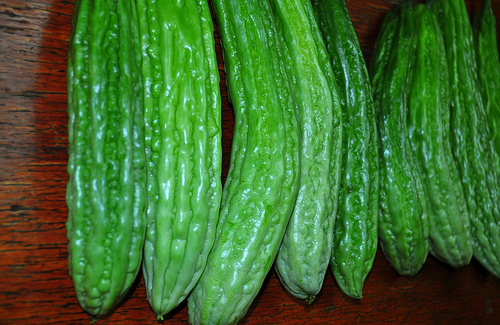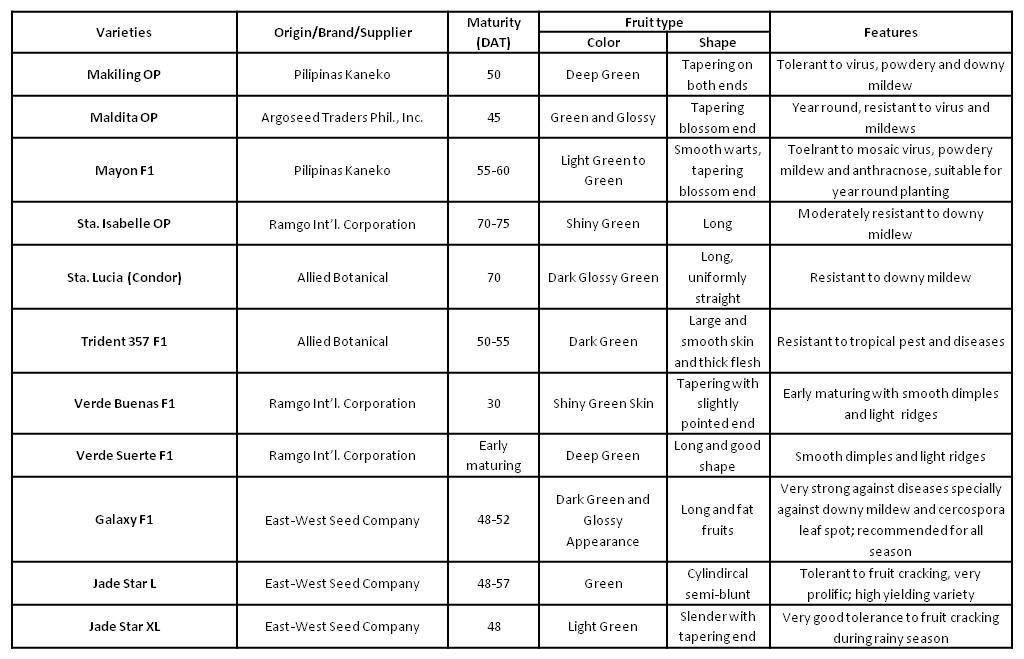Bitter Gourd (Momordica charantia), is known in the Philippines as “ampalaya”. It is a tropical and subtropical vine of the family Cucurbitaceae. It is widely grown for its edible fruits and shoots, and for its nutrients and medicinal properties. The crop has been a folkloric cure for generations but has now been proven to be an effective herbal medicine for many ailments.
Grow Ampalaya for Business

The Philippine variety has proved to be the most potent. It contains a mixture of flavanoids and alkaloids which makes the pancreas produce more insulin that regulates the blood sugar in diabetics. It has many other herbal benefits such as antioxidant, paraciticide, antibacterial and antipyretic. Aside from its medicinal value, it is a good source of vitamins A, B, and C, iron, folic acid, phosphorus and calcium.
Ampalaya is prepared in various dishes such as stir-fried with ground beef and oyster sauce or with eggs, with diced tomato and pinakbet, a very popular dish of the Ilocanos. The young shoots and leaves are eaten as greens/salad.
The demand for ampalaya in the market is great. In off-season planting, 1,000 sq m. area can give an income of P15,000 per cropping.
SOIL AND CLIMATIC REQUIREMENTS
You can grow ampalaya in any type of soil. However, the best type and texture of soil for this crop is sandy loam or clay loam with good drainage, high organic matter and with pH ranging from 6 to 6.7.
The crop can be planted throughout the year but the best season is from October to February. High production is obtained during the cool months because more fertilized flowers are produced during this period.
CULTURAL MANAGEMENT PRACTICES
Selection of Varieties
For better yield and profit, select varieties that are adaptable to local conditions, resistant to major insect pests and diseases and market preference. Two types of ampalaya varieties are available in the market. These are the open pollinated varieties (OPV) and the hybrid varieties.
OPV types are available at the nearest Reasearch Outreach Stations (ROS) and hybrid varieties are available at local agricultural input dealers. To guide you in selecting your choice varieties, please refer to the “Guide in Selecting Lowland Vegetable Varieties” included in this kit.

Land Preparation
Prepare the land thoroughly. The soil must be well pulverized and leveled to obtain maximum yield. Plow and harrow the field twice at seven (7) days interval.
Trellising
Trellises provide support to climbing vegetables. It promote good quality fruits. It also facilitates cultural management operations.
After second harrowing, construct trellis at a distance of 2.5 to 3.0 m wide and 1.5 to 2 m high. The length of the trellis depends on the area of the field. Provide bamboo or wooden post at every 3 m distance. Provide a strong roof trellis by intertwining tie wire or nylon twine crosswise and lengthwise on top of the trellis.
On the sides of the trellis, intertwine layers of tie wire or nylon as climbing support for ampalaya. Fix a plastic string or straw twine on the sides of the trellis along ampalaya hills to facilitate the vines to climb up.
Old fish nets or fish cage nets can also be used as materials for ampalaya vines to crawl on. Fix the nets on the sides of the trellis.
Seed Preparation
Break the seed coat lightly or cut the pointed tip using nail cutter and soak the seeds in clean water for 24 hours. Pre-germinate the seeds using a rag doll method. Wrap the seeds with a damp cloth and place in cool and dark place. Incubate for 24 to 48 hours or until the radicles emerge.
Planting
Direct Planting
Plant one seed per hill along the furrows at a distance of 30 to 50 cm between hills. Replant diseased and dead seedlings and missing hills 15 days after emergence.
Transplanting
- Use potlets or seedling trays to grow seedlings.
- Prepare and mix thoroughly potting medium of 1:1:1 garden soil, Carbonized Rice Hull (CRH) and compost.
- Fill the container with mix media.
- Plant one seed per potlet or tray hole filled with a prepared planting media.
- When the seedlings emerge, water the plants regularly when needed.
- When the seedlings are grown, harden them by gradually reducing water application and by exposing them under the sun.
- Transplant at 15 days after sowing or when true leaves have developed. Do not delay transplanting because this will result to poor plant growth and high mortality.
- Transplant late in the afternoon for higher percentage recovery of seedlings.
- Apply starter solution by dissolving one tbsp of urea (46-0-0) to 6 liters of water and use as drench for seedlings at transplanting. After drenching, the seedlings should be sprinkled with clean water immediately to avoid burning effects.
Fertilizer Application
Apply 10 to 20 tons organic fertilizer per hectare or decomposed animal manure or compost before field preparation to supplement inorganic fertilizer. At planting, apply complete fertilizer (14-14-14) at the rate of 20 grams or two tbsp per hill. Sidedress with urea at the rate of 10 grams or one tbsp per hill before hilling up (3 to 4 weeks from planting). Repeat application every 2 weeks for at least 2 to 3 times more. Cover the fertilizer with at least 6 cm of soil after application.
Irrigation
Irrigate the field when necessary during the growing period of the plant. Furrow irrigation can be applied. Ampalaya cannot tolerate water logging hence a drainage canal should be provided.
Prunning
Remove all lateral vines and old leaves from the base up to 1 m above so that nutrients are concentrated on the fruiting branches and fruits. Maintain single or two lateral vines only. This will enhance fruiting ability of the plants with bigger and quality fruits. Cut lateral vines can be sold in the market at a good price for an additional income.
Cultivation and Weeding
Off-bar the plants at 7 to 10 days after planting to control weeds. Hill up at 15 to 20 days after off-barring or during the application of sidedress fertilizers. Hand weed the base of the plants regularly to avoid the weeds competing with plants in nutrient and water uptake.
Crop Protection
Plants should be protected from pests and diseases to ensure good yield. The most destructive pest of ampalaya is fruitfly and the most common disease is bacterial wilt. Practice good cultural management and sanitation to prevent insect pests damage and disease infection. The “Insect Pest and Disease Management Guide” included in this kit presents the details in managing insect pest and diseases of ampalaya.
Harvesting and Postharvest
Harvest fresh fruits 18 to 20 days after blooming or when the fruits attain full size but the seeds are still immature. This takes about three weeks after petal fall. Sort harvested fruits according to class. Pack sorted fruits in boxes or polyethylene bags ready for marketing.
Source: http://e-extension.gov.ph

Pls. post a picture of the trellis.
oh! this is so very helpful in our investigatory project
Thanks
thanks for infolinks…
thank's for the effort!!!
wooo